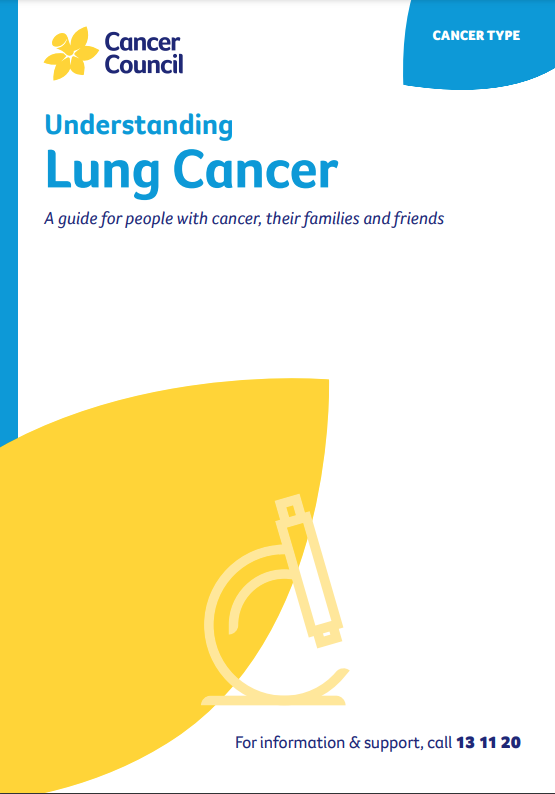- Home
- Lung cancer
- Diagnosis
- Tests
Lung cancer tests
Checking for lung cancer usually involves a number of tests.
The tests you have depend on your specific situation and may include:
Initial tests
The first test is usually a chest x-ray, which is often followed by a CT scan. You may also have a breathing test to check how your lungs are working and blood tests to check your overall health.
Chest x-ray
A chest x-ray is painless and can show tumours 1 cm wide or larger. Small tumours may not show up or may be hidden by other organs.
CT scan
A CT (computerised tomography) scan uses x-ray beams to create detailed, cross-sectional pictures of the inside of your body. This scan can detect smaller tumours than those found by chest x-rays. It provides information about the tumour, the lymph nodes and other organs.
CT scans are usually done at a hospital or radiology clinic. You may be asked to fast (not eat or drink) for several hours before having the scan.
Immediately before the scan, a liquid dye is injected into a vein. This dye is known as contrast, and it makes the pictures clearer. The contrast may make you feel hot all over and leave a bitter taste in your mouth, and you may have nausea (feel sick) or feel a sudden urge to pass urine (pee or wee). These sensations should go away quickly, but tell your doctor if you continue to feel unwell.
The CT scanner is a large, doughnut-shaped machine. You lie still on a table while the scanner moves around you. Getting ready for the scan can take 10–30 minutes, but the scan itself takes only a few minutes and is painless. A low-dose CT scan, which uses less radiation, has been shown to find lung cancer in people with no signs or symptoms.
In July 2025, the Australian Government is introducing a national lung cancer screening program (NLCSP) using low-dose CT scans. It is for people aged 50–70 years old who have smoked at least 20 cigarettes a day for 30 years (or the equivalent, e.g. 40 cigarettes a day for 15 years), and smokers who have quit in the last 10 years.
Talk to your GP or call Cancer Council 13 11 20 for updates on this screening program.
Before having scans, tell the doctor if you have any allergies or have had a reaction to contrast (dye) during previous scans. You should also let them know if you have diabetes or kidney disease, or are pregnant or breastfeeding.
Learn more about CT scans.
Lung function test (spirometry)
This test checks how well the lungs are working. It measures how much air the lungs can hold and how quickly the lungs can be filled with air and then emptied.
For a lung function test, you will be asked to take a full breath in and then blow out into a machine called a spirometer. You may also have a lung function test before you have surgery or radiation therapy.
Blood tests
A sample of your blood will be tested to check the number of red blood cells, white blood cells and platelets (full blood count), and to see how well your kidneys and liver are working.
→ READ MORE: Tests to confirm diagnosis
Podcast: Tests and Cancer
Listen to more of our podcast for people affected by cancer
More resources
Dr Malinda Itchins, Thoracic Medical Oncologist, Royal North Shore Hospital and Chris O’Brien Lifehouse, NSW; Dr Cynleen Kai, Radiation Oncologist, GenesisCare, VIC; Dr Naveed Alam, Thoracic Surgeon, St Vincent’s Hospital, Epworth Richmond, and Monash Medical Centre, VIC; Helen Benny, Consumer; Dr Rachael Dodd, Senior Research Fellow, The Daffodil Centre, NSW; Kim Greco, Specialist Lung Cancer Nurse Consultant, Flinders Medical Centre, SA; Caitriona Nienaber, 13 11 20 Consultant, Cancer Council WA; Marco Salvador, Consumer; Janene Shelton, Lung Foundation Australia – Specialist Lung Cancer Nurse, Darling Downs Health, QLD; Prof Emily Stone, Respiratory Physician, Department of Thoracic Medicine and Lung Transplantation, St Vincent’s Hospital Sydney, NSW; A/Prof Marianne Weber, Stream Lead, Lung Cancer Policy and Evaluation, The Daffodil Centre, NSW.
View the Cancer Council NSW editorial policy.
View all publications or call 13 11 20 for free printed copies.

